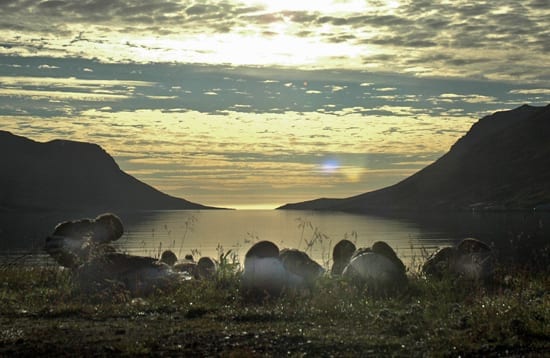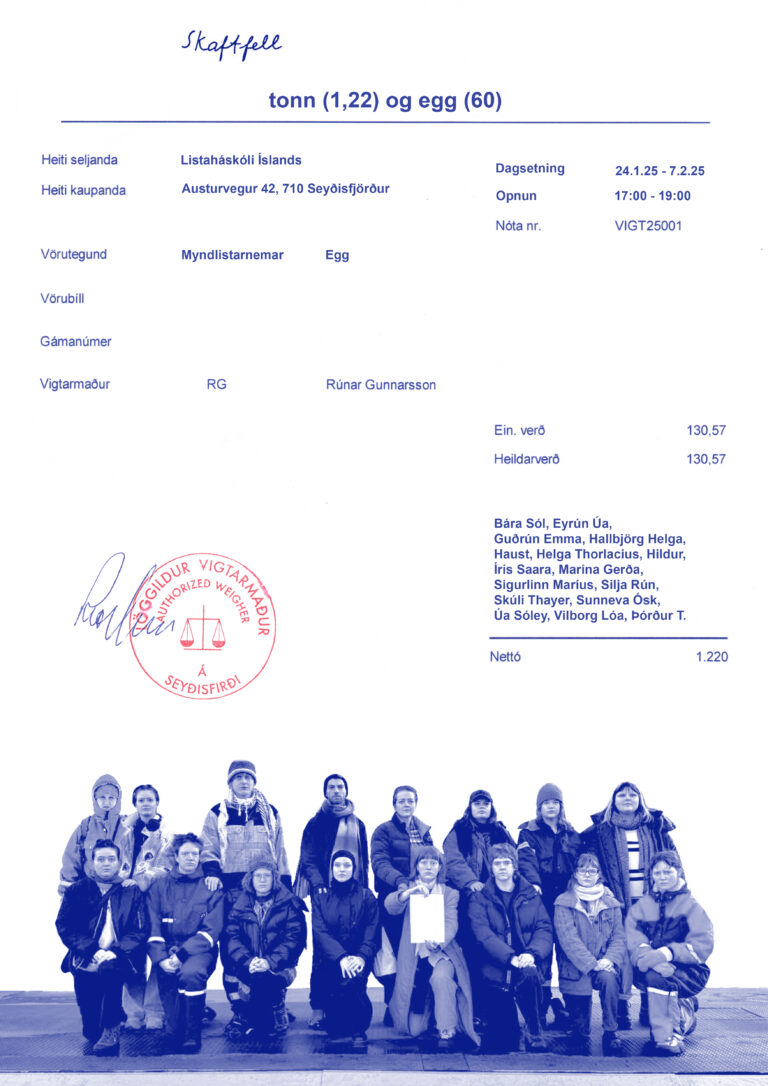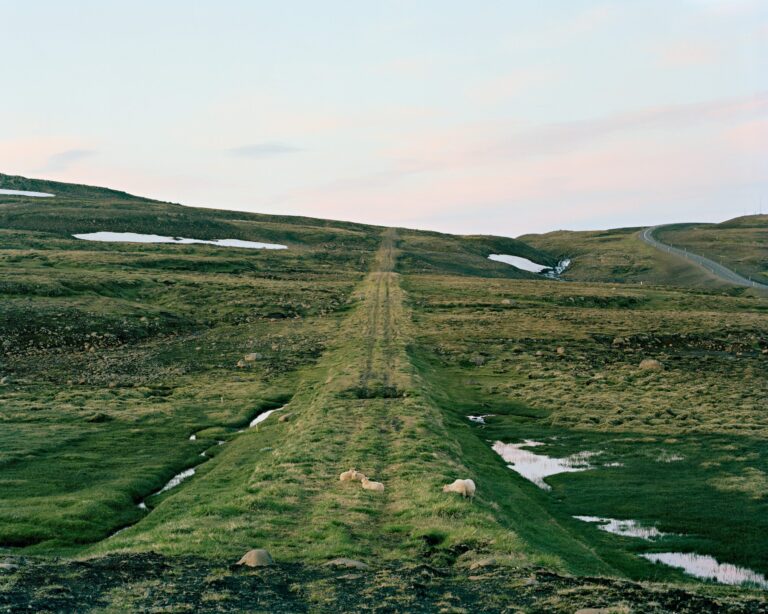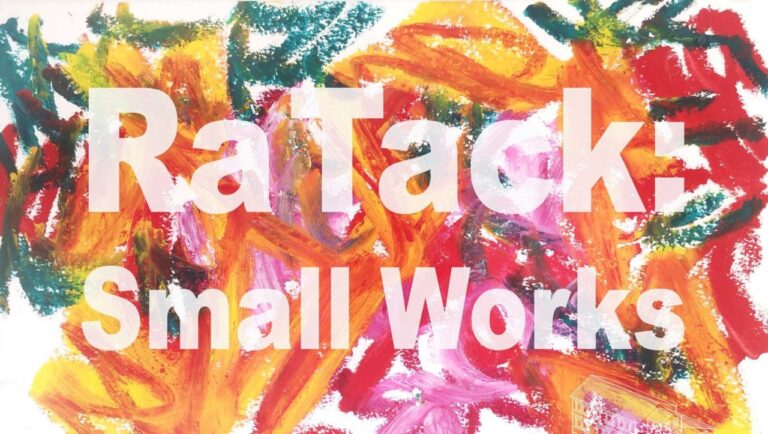The Skaftfell summer exhibition 2014 is entitled RÓ RÓ and presents a group of local and international visual artists who are in an active contact with Seyðisfjörður, a village with 670 inhabitants in East Iceland. Some of the artists live permanently in the town, others own houses or reside regularly in the fjord. On exhibition are new or recent works, which are made locally or refer to the place, in the Skaftfell gallery as well as various sites and venues throughout the town. Parallel is an event program that will take place over the course of the exhibition.
The title RÓ RÓ combines two important factors that provide for the thriving cultural life of the town, that has taken place not only for the last years, but also for over a hundred. Firstly, ró meaning quiet in Icelandic, acknowledges the calm and serene environment many artists seek to pursue their practice. Seyðisfjörður is a haven for a number of artists. Secondly, RÓ RÓ also refers to the act of rowing, or fishing, that is a fundamental part of the industrial activity of the town.
Ráðhildur Ingadóttir who serves as an honorary artistic director in Skaftfell 2013-2014 curates the exhibition. With this project Ingadóttir wants to direct the attention to the vigorous visual art scene in Seyðisfjörður.
All of the artists involved in the exhibition have in the past been very involved in Skaftfell. Most of them have exhibited previously in the center, served as a board member, stayed as artists in residence etc. This human capital that Skaftfell can depend on is the backbone of the center.
Skaftfell – Center for Visual Art was founded by the so-called Skaftfell group in 1998. The oldest participant in the exhibition, Garðar Eymundsson, and his wife Karólína Þorsteinsdóttir, gave the house Skaftfell to the group in the intention that it be being used for cultural activities. The initiative of the Skaftfell group was inspired by the Swiss artists Dieter Roth (1930-1998), that had been periodically residing in the Harbour house, Bryggjuhús, in Seyðisfjörður with his son and collaborator Björn Roth.
It is safe to say that Skaftfell would not have flourished without the help and positive support from the community, institutions, companies and individuals in town. The positive attitude of the various town councils that have ruled since Skaftfell started has been crucial, as have companies like Stjörnustál, Brimberg Seafood and Síldarvinnslan, important collaborators as the Technical Museum of East Iceland and the brothers Sigurbergur Sigurðsson and Þorgeir Sigurðsson, and many many more. Guðmundur Oddur Magnússon, designer and professor, is one of the many who reside in the fjord in the summertime and has contributed to the center greatly by designing posters, catalogues, and more, as he also does for this exhibition.
Summer event program
Tuesday June 17, at 16.00
RÓ RÓ opening at Skaftfell. Guest are invited for a walk to outdoor works around town and Gunnhildur Hauksdóttir will perform the Names.
In the evening at 21.00 the audiovisual collaboration NS-12 by Kristján Loðmfjörð and Konrad Korabiewski will be presented in Brimberg Seafood at, harbour entrance.
Sunday July 6, at 15.00
Tvísöngur festival, acoustic
Sunday August 3, at 15.00
Performances: Auxpan, Borghildur Tumadóttir, Daníel Karl Björnsson and Gunnhildur Hauksdóttir
Sunday August 3, at 16.00
The Mountain lady festival, open participation
Saturday August 23, at 15:00
Létt á bárunni performs Sexí
Guided tours on Wednesdays at 16.00, 500 ISK.
RÓ RÓ is running through October 5, 2014.
Skaftfell is open daily from 12.00 – 22.00 and admission free.
Location for outdoor works
Artists bio´s
Berglind Ágústsdóttir, 1975, graduated from Iceland Academy of the Arts in 2003. She has been active in the art scene, both domestic and internationally since. Berglinds involvement with the arts includes in events, as curator and musician, as well as artist. Berglind has played music around the world and published her music in the form of cd and as cassettes. She draws attention wherever she goes and there is no doubt about it that her art is paired with her appearance and attitude in daily life. Just like in her life she uses colour, patterns, toys and photographs to express her matter of heart. Berglinds works in performance, music and installation. She first came to Seyðisfjordur in the year 2003 to participate in the Dieter Roth Academy and she has come every year since, for short and long stays. Berglind has participate in many art happenings in the village, including the group exhibition we love iceland, she has played on the art festival LungA and is one of the founders of Fjallkona, a association for a growing cultural life in Seydisfjordur. In the year 2014 Berglind moved to Seydisfjordur and runs a d.i.y residency, an open studio space and residency. In her home she works on her art and music as well as experimental radio eg. Berglind considers Seydisfjordur her second home, but she also lives in Berlin.
Birgir Andrésson, 1955-2007, as born on the Westman Islands, but moved to the main island during childhood. He began studying at the Icelandic College of Arts and Crafts in 1973, and continued Graduate studies in Holland from 1978-80. Upon completion Birgir returned to Iceland where he worked as an artist and designer. In 1995 Birgir represented Iceland in the Venice Biennale. He bought Hóll, one of the old houses in Seyðisfjörður, where he stayed many times.
Björn Roth, 1961, was born in Reykjavík in 1961. He studied at the Icelandic College of Arts and Crafts and worked closely with his father Dieter Roth from 1978 until Dieters death in 1998. Björn is of the generation of Icelandic artists that arose with a departure from the traditional method and material use present during the time. This new department in the Arts and Crafts College became a platform for conceptual forms, new painting, newwave and punk. Björn has worked interchangeably within art, teaching and curating. He purchased The Harbour House during the nineties and has been involved greatly with Skaftfell since its beginnings.
Borghildur Tumadóttir, 1989, has been coming to Seyðisfjörður since she was 15 years old. With time she has learned to appreciate the beauty that surrounds the town as a mental stability and inspiration
Daníel Karl Björnsson, 1974, was born in Reykjavík where he currently lives and works. He graduated from Iceland Academy of the Arts in 2002, and has been active in exhibiting, as a curator, teacher and organizer both nationally and internationally. He is one of the founding members of Kling & Bang gallery, and has been involved in running the gallery since the beginning of 2003. Daníel has a long lasting relationship with Seyðisfjörður that carries back 15 years or so, with many trials of art and life.
Dieter Roth, 1930-1998, was born in Hannover, Germany. As one of the pioneers of graphic art, he is internationally recognized for his contributions to the medium of the artist book. Dieter moved to Iceland in 1957, where he began his family. Together with his son, Dieter purchased The Harbour House in the nineties, and he stayed often in Seyðisfjörður.
Elvar Már Kjartansson, 1982, has been an electronic musician since the last millenium. He has been around and been an exemplary. Elvar bought the Ironhouse in Seyðisfjörður with his wife, Hanna Christel, and they have lived in the village, and Reykjavík, ever since.
Garðar Eymundsson, 1929, was born in the house called Baldurshagi in Seyðisfjordur. He is the oldest participant in RÓ RÓ, and it was he and his wife Karólína Þorsteinsdóttir who gifted the house, which is now Skaftfell, for the purpose that it would be used in favor of art and cultural. Garðar worked as a carpenter, but at the age of seventy-eight the painting brush, rather than the hammer, became his main tool.
Garðar Bachmann Þórðarson, 1986, was born and raised in Seyðisfjörður. He is currently living in Copenhagen but still holds a strong connection to Seyðisfjörður and is the grandchild of Garðar Eymundsson. Garðar has been making movies for the past years alongside working as a chef.
Gunnhildur Hauksdóttir, 1974, was born in Reykjavík, but lives and works in Seyðisfjörður and in Berlin, Germany. She received her MFA from the Sandberg Institute in Amsterdam in 2005 after completing her BFA from the Icelandic academy of the Arts in 2001. She is a member of the Dieter Roth Academy since her early visits to Seyðisfjörður in 1999. Gunnhildur works in sculpture, audio, video and performance. Among her most recent solo exhibitions & performative projects are Der Abstand, a performance for Franz Graf´s project Siehe was dich sieht in 21Haus in Vienna (AU 2014), The Assembly of the Holy in the National Gallery of Iceland in Reykjavik (IS 2013), Stars in Context Gallery in Derry (NI 2011), My Gift, Your Excellency in ASÃ Art Museum (IS 2011). She serves on the board of the Living Art Museum and was head of the board and Director from 2011-2013. She is a visiting Artist at the Icelandic Academy of the Arts in the fine arts department.
Hanna Christel Sigurkarlsdóttir, 1977, has an BA-degree from Iceland Academy of the Arts (2002). Since the she has participated in many group exhibitions and solo exhibition. In the year 2008 she and her husband, Elvar Már Kjartansson, bought the Ironhouse in Seyðisfjörður and they have lived in the village, and Reykjavík, ever since.
Helgi Örn Pétursson, 1975, is born and bred in Reykjavík. Helgi is an artist of chaotic and yet calculated proportions. He has lived and worked in Seydisfjördur since 2006, the year he graduated from the Iceland Academy of the Arts, Visual arts department. Through the years Helgi Örn´s work has taken the multi-layered form of performance that draws from the world of music and dance. His performances are often a collaboration with other like-minded artists working, and bordering on the exchange of music and visual art. In addition Helgi Örn works with drawing and is a skilled craftsman, illustrator and layout artist as well as curator, theatre technician and designer
Ingirafn Steinarsson, 1973, was born in Sweden and moved to Iceland 1980, and he lived in Reykjavik as a child and teenager. Ingirafn studied at the Icelandic Collage of Art and Handicrafts during the years of 1997 to 1999. From 2003 to 2006 he studied at the Malmö Art Academy. Ingirafn then moved back to Reykjavik and worked and lived there. In the year 2013 he bought a house in Seyðisfjörður, Báran, with his wife Benedikta Svavarsdóttir. Currently they are renovating the house.
Jökull Snær Þórðarson was born December 21st 1988 in Seyðisfjörður.
Julia Martin, 1976, was born and raised in Berlin. She studied landscape architecture in Berlin, and then art in Edinburgh and London. Her work explores the many different ways in which people perceive, imagine, use, and describe nature – as idea and reality. She has documented renewable energy schemes around the coast of Scotland, as well as the disappearing dogsledding-culture in West Greenland, and has shown exhibitions in Japan, Berlin, Shetland, Edinburgh, and Seydisfjördur. Her latest project is a case study of Kárahnjúkar Hydroelectric Project and its extensions in East Iceland. It investigates the ecological and social relationships between objects, infrastructures, landscapes, economies, and people, showing that the idea of ecology as a complex system contains much more than just nature elements. The fieldwork for this project brought Julia to Skaftfell Center for Visual Art three times as artist-in-residence, from 2011 to 2012, and she has been coming back to Seydisfjördur ever since.
Konrad Korabiewski, 1978, is a sound-artist, composer and media artist. He has a minimalist, yet detail-oriented unconventional and experimental artistic approach, characterized by a marked tendency to transgress various genres and media. Focused on absorption, content and substance of art rather than a certain media, he experiments and develops new possibilities for sensing and expressing philosophical views and artistic ideologies. This is also highly visible at Korabiewskis live performances, where he involves other actors and medias to add layers and new dimensions to his music, sound and radio art pieces, installations and video works. As with his pioneering and prize awarded crossover, interactive art-book project Affected As Only A Human Being Can Be (2010) with the mixed media artist Litten. Korabiewski is a founder and currently director of Skálar Centre for Sound Art and Experimental Music, and running residency Gallery and Art studio HOF in Seyðisfjörður, Iceland. He holds a Master degree in Electronic Music Composition from The Royal Academy of Music, Aarhus, Denmark.
Kristján Loðmfjörð, 1977. In the late nineties Kristján Loðmfjörð founded the film association Lortur along with his friends. Lortur produced experimental films as well as hosting the visual art biennale Drum Solo. Later on Kristján studied visual art in a Dutch small town, which he graduated from in the year 2006. Using audiovisual mediums Kristján explores the means of the narrative form without narration. In the year 2012 Kristján followed his partner and three children and moved to Seyðisfjörður. In Seyðisfjörður women control culture and men attend the housework.
Kristján Steingrímur, 1957, lives and works in Reykjavik. He studied in Icelandic College of Art and Handicrafts from 1977 to 1981 and the University of Fine Arts of Hamburg in Germany from 1983 to 1987. Kristján has a house in Seyðisfjörður where he stays regularly and works on his arts. Every year he teaches a course with Björn Roth in the Iceland Academy of Arts in Seyðisfjörður.
Linus Lohmann, lives and works in Seyðisfjörður.
Litten Nyström, 1977, was born in Aarhus, Denmark. As an adult she has mainly been living and studying in Copenhagen until she longed for something bigger and hence bought a house and moved to Seyðisfjörður after a brief artists residency at Skaftfell in 2011.
Lukas Kuhne is a German sculptor, he lives in Montevideo, Uruguay. His works have often interdisciplinary contents and been shown in Europe, Iceland, Japan, North and South America. His current work is dedicated to spatial and acoustically impacts.
Marcellvs L., 1980, was born in Belo Horizonte, Brazil and lives between Berlin and Seyðisfjörður. Working in both video and sound, he has exhibited internationally since mid 2000. Among recent solo exhibitions are Indiferença at Galeria Luisa Strina in São Paulo, COMMA 34 at Bloomberg Space in London, VideoRhizome at Kunsthalle Wien in Vienna and Infinitesimal at carlier | gebauer in Berlin. He has participated in numerous group exhibitions and Biennials, such as the 16th Biennale of Sydney (2008), 9th Biennale of Lyon (2007) and 27th Biennale of São Paulo (2006). He has received the Ars Viva Price prize for 2007/08.
Monika Fryčová, 1983, is an audiovisiual artist, performer, writer and a private ethnographer. She lives and works in Iceland, Czech Republic and Portugal. Monika received her Masters degree from the Fine Arts, Brno University of Technology, Atelier of Video, Czech Republic (2010), and she also studied in the Iceland Academy of Arts (2006), and independently in California/Mexico (2004/5) with various artists. From 2013 PhD. studies (Artist as an Ethnographer). Her research speculates upon the less charted regions of human existence: principles of chaos, intuition, perceptions and mythology. In recent years she has been focused on Iceland due to its intense confrontations of the elements and unique meetings, curator of few international projects mainly Czech Icelandic ( ISLANDIA, NoD, gallery SKOLSKA28/Prague, OPEN SPRINGS/Reykjavik, Untitled Festival/Bildudalur, DIRECTRIX with E. Isleifsdottir etc.) Currently Monika works on permanent project Fantasy versus Discipline and organizes intercultural dialogue between Iceland and Portugal.
Pétur Kristjánsson, 1952, was born in Minnesota. He is an agronomist from Hólar Collage and has a BA in ethnology from Lund University in Sweden. Pétur has worked on farms, on fishing boats, in mechanical shops, as a translator and taught in Seyðisfjörður elementary school for many years. He worked for and with Dieter Roth 1991-1998. After being involved with the Technical Museum for East Iceland from 1984, he became its full-time conductor in 2002. Pétur is a professor of the Dieter Roth Academy and former Chairman of the Board for Skaftfell. He is married to Þóra Ingvaldsdóttir and they have one daughter.
Ráðhildur Ingadóttir, 1959, has worked as a visual artist for many years. She studied in Britain, but lives and works in Denmark and Seyðisfjörður, Iceland. Ráðhildur´s projects are varied. She has worked as a part-time teacher at the Iceland Academy of the Arts and has been very active in exhibiting in recent years, both in Iceland and abroad.
Roman Signer, 1938, was born in 1938 in Switzerland. He is a well-respected contemporary artist, who has often stayed in Iceland.
Rúnar Loftur Sveinsson, 1949, was born and raised in Reykjavik. He was a fisherman for some decades but in the year 1998 he came to Seyðisfjörður to work in the net making factory for one month. Later that year he bought a house in the village and hasnt moved away since. Rúnar Loftar has been drawing since childhood but in the year 2006 he started to study oil painting under the guidance of Garðar Eymundsson. Rúnar Loftur paints houses and contemporary life.
Tinna Guðmundsdóttir, 1979, lives and works in Seyðisfjörður. She graduated in 2002 from the multimedia department in Iceland Academy of the Arts. Tinna visited Seyðisfjörður for the first time in February 2002 when she participated in the the Seyðisfjörður workshop through her studies and was hosted by Skaftfell. The beautiful fjord was visited again in 2007 and 2009 in relation with Skaftfell. In the beginning of 2012 Tinna moved to Seyðisfjörður and is now a proud house owner.
Tumi Magnússon, 1958, was born in 1958 in Reykjavík. For many years he has worked as an artist, living between Denmark and Seyðisfjörður.
Þórunn Eymundardóttir, 1979, is based in the remote town of Seydisfjordur, Iceland. Her work is based on the media of performance though it frequently takes on the form of installation. The boundaries between the self and the other / the inner and outer being, and the elevation of everyday life are the core elements of her work. The work tends to be more the moment than the material although there is always underlying the aesthetic quality distinctive to her language. Although inclined to work on site- and time based projects, Thorunn produces various types of works which are a continuation of her larger scale projects. These include works on paper, photographic series, objects, video and texts.
Supporters






